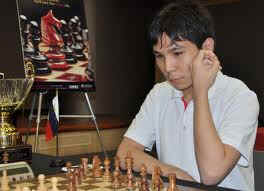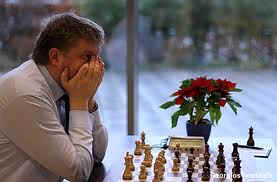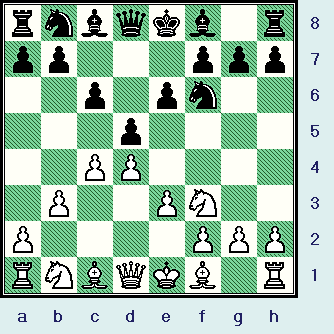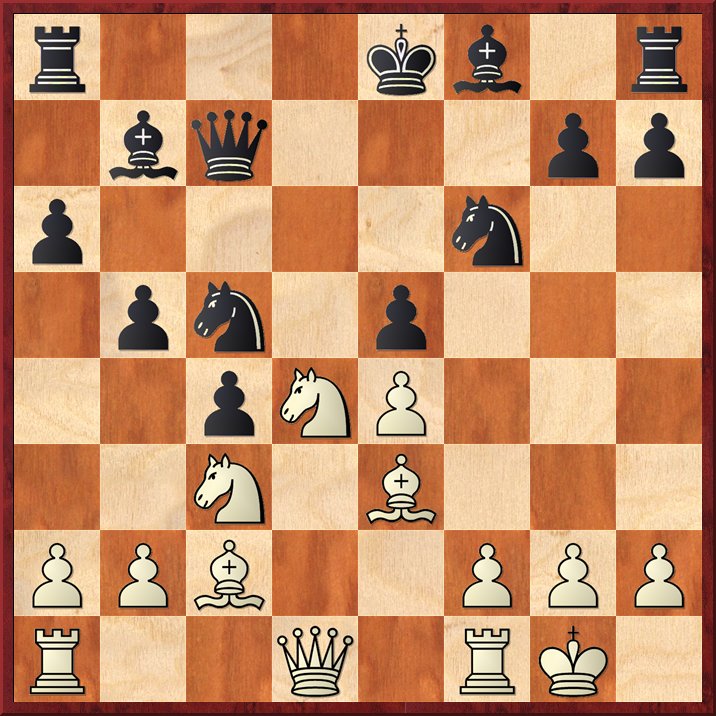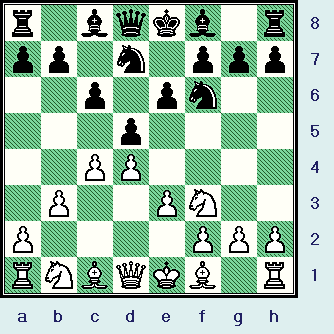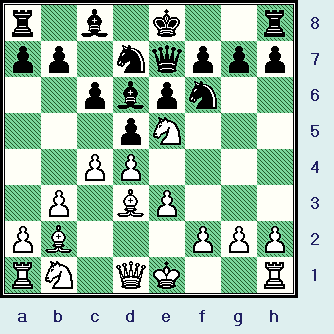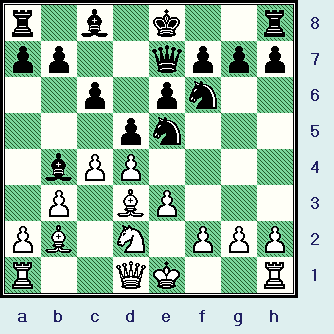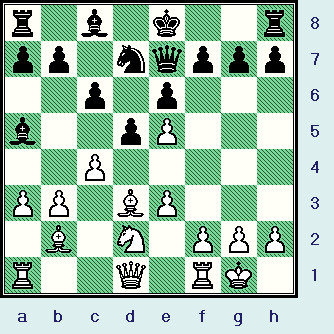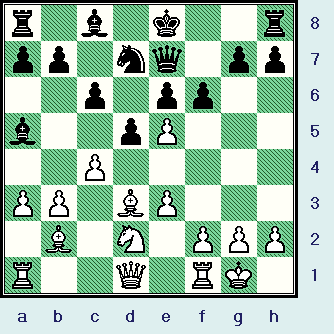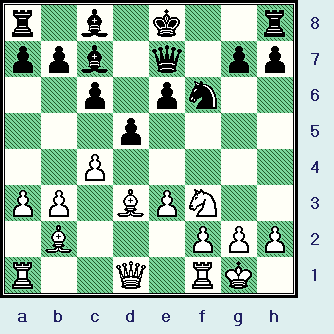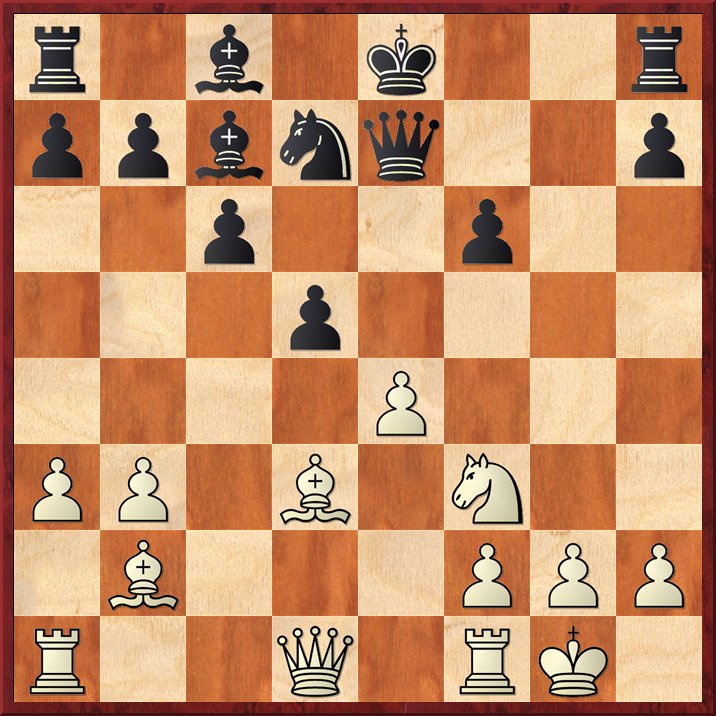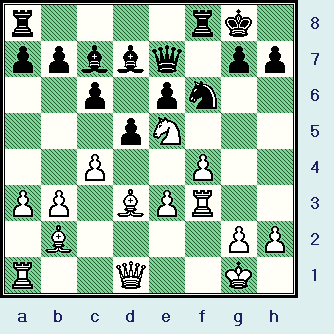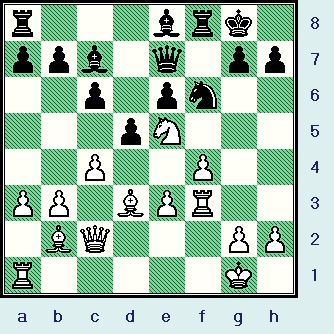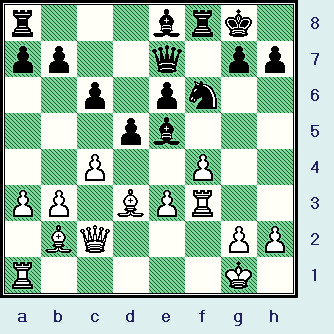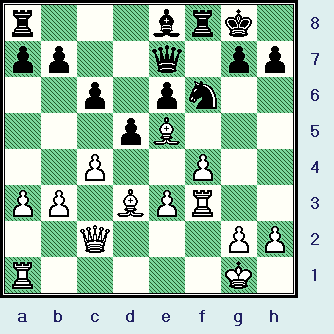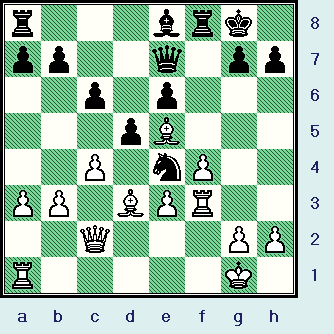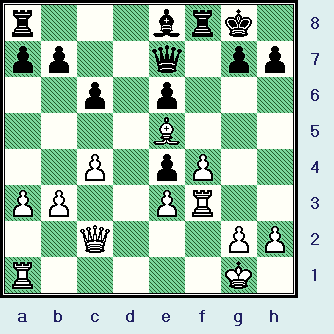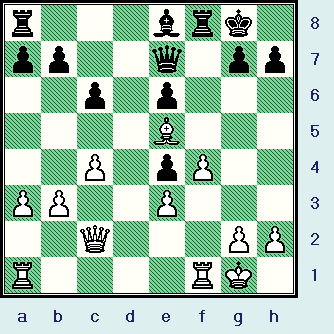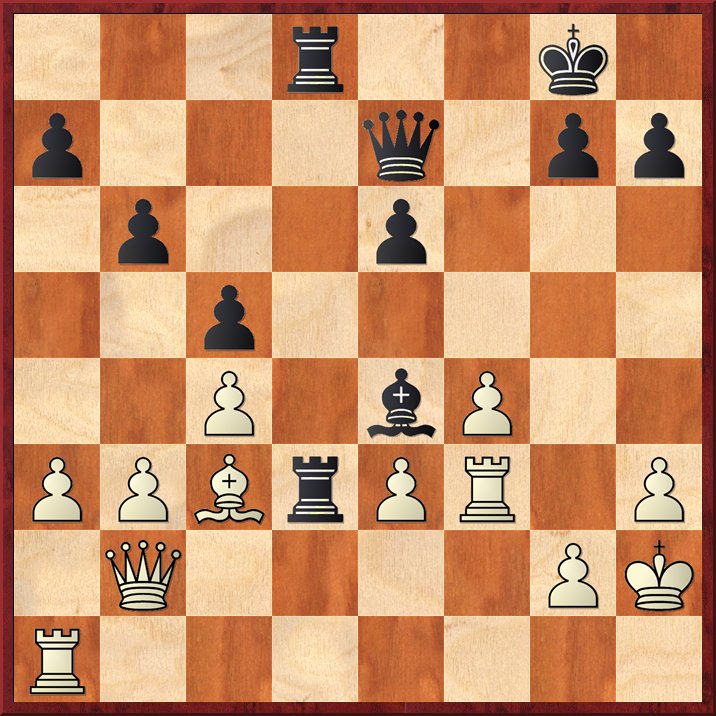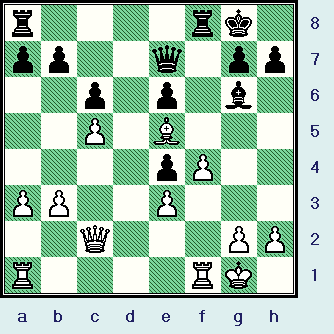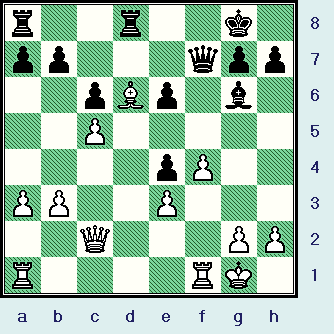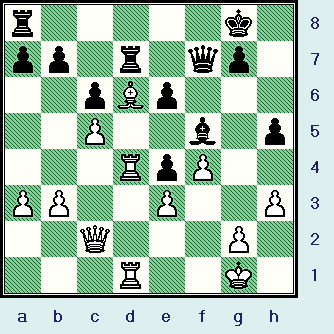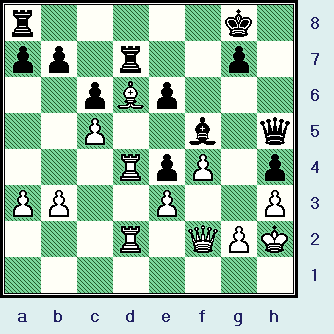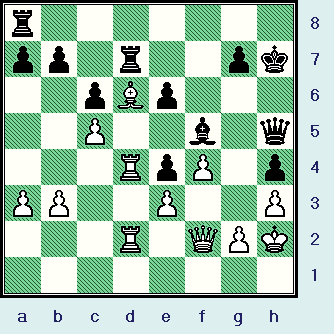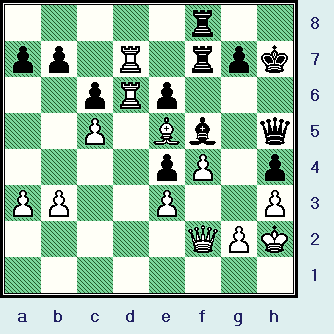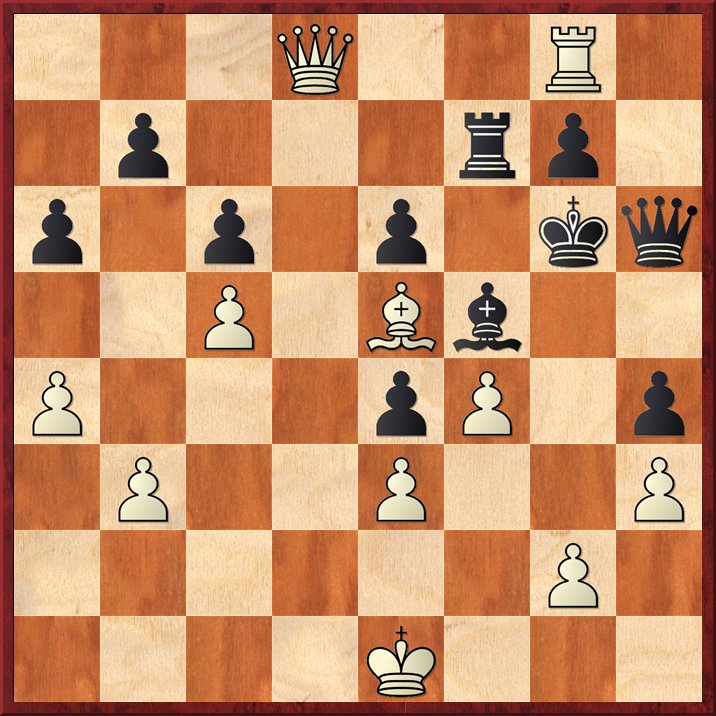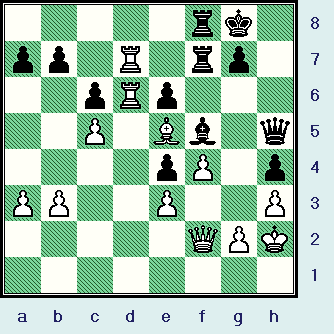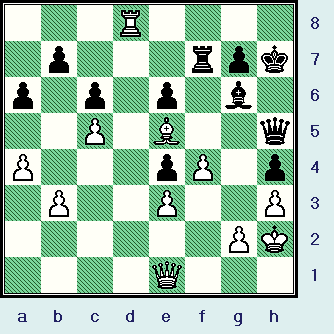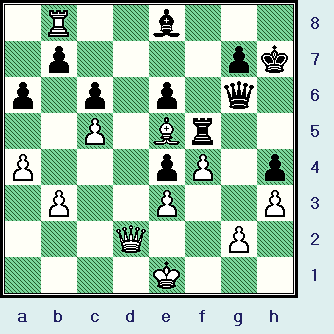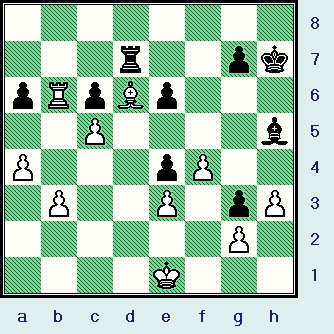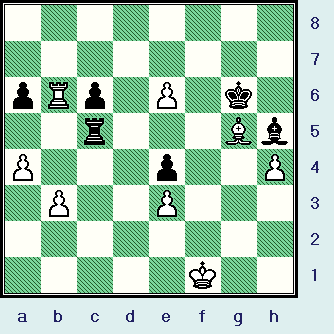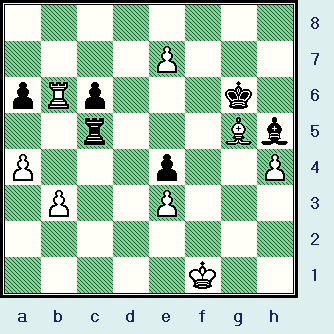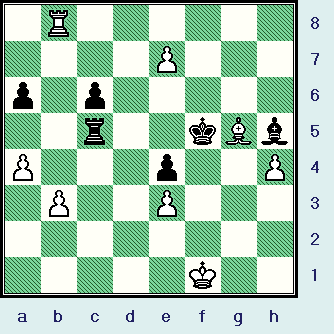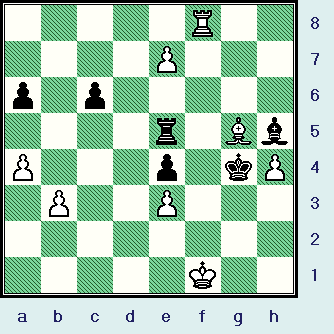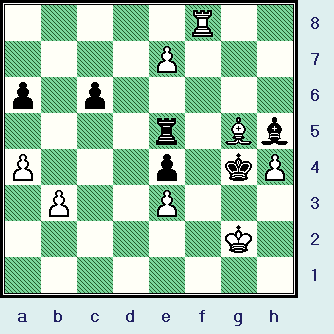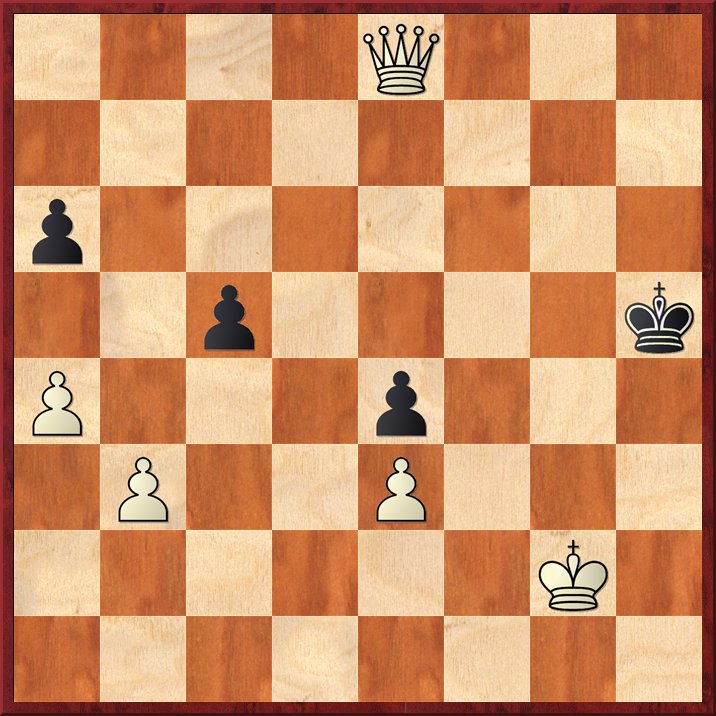All
the |
(Navigation bar
directly below.)
*******
© A.J. Goldsby, 2015.
(All rights reserved.)
****************
Click HERE
to see my
Chess Items.
****************
****************
Buy a book
from Amazon.com
(And help me out as well!)
****************
Click HERE
...
to see a list of the businesses that help to sponsor all of
my chess efforts.
|
Wesley
So - Alexei Shirov |
|
|
|
|
GM Wesley So |
GM Alexey Shirov |
|
His FIDE card; his CG player profile. |
His FIDE card; his CG player profile. |
Click HERE to see an explanation of the symbols that I commonly use when I annotate any chess game.
Click HERE to replay this game ... on another server.
Click HERE to see some other cool links on this game. (Type in "chess, W So, A Shirov;" and then hit enter.)
*************************************************************************************************************************************************************************
Click HERE
to watch part #01 of my CHESS VIDEO (on this game) on the "You Tube"
server!
(Watch
for future installments as I finish them and then post them.)
Chess Video's: Part I, Part II, Part III, Part IV, Part V, Part VI.
GM Wesley So (2667) -
GM Alexei Shirov (2701)
|
|
|
[A.J. Goldsby I]
This is one of Wesley So's finest wins, his fans asked that I do an analysis of this contest.
GM Wesley So is truly a chess prodigy! He is one of the youngest GM's (ever) from his region of the world - and, as I write this in 2011 - he is also the 7th youngest GM of all time!!!
In the following game, our hero defeats the veteran, GM Alexi Shirov. Displaying a maturity beyond his years, So slowly builds the pressure, forcing one tough decision after another on poor Shirov. White doubles his heavy artillery on the d-file while Black seeks counterplay on the Kingside. But the wiley Shirov always seems to always be just one-step behind his youthful antagonist; and in the end, there is no saving his game. Please note White's brilliant twenty-first move, foregoing the (seemingly obvious) capture of the e-pawn. See how effectively GM W. So plays the endgame - which is always a sign of great chess talent. In the end, Black finally resigns after the quiet, but effective and decisive play of 59.Kg2!, sealing the Black King into a mating net. (There can be no constructive response to such a play. Shirov could have dragged the game out, however - in a true gesture of sportsmanship, befitting such a fantastic struggle - GM A. Shirov simply struck his colors, and called it a day.)
For me, this game is like a
symphony by Beethoven or Mozart. Each part of the clash is reflected by the music, each
phase has several distinct movements. There are periods of flurried activity,
followed by peaceful chords and notes, each perfectly played on the instruments
by the hands of the great masters. It ends with a melodic movement ... and then a sudden crescendo. The
conductor waves his arms, and then suddenly brings them down; which is a signal to all who are watching that the final notes have been played, and that the performance
is now over. For a few moments, there is a perfect, reverent silence ... ... ...
... and then the audience spontaneously rises to their feet to give a long and
heartfelt standing ovation.
***************************************************************************************************************************************
1.d4 d5; 2.c4 c6; 3.Nf3 Nf6; 4.e3 e6; 5.b3!?, ( Pawn-structure? {The dark squares - on the Q-side.} )
This is a variant that is not
commonly used, and this is ... (as far as I was able to try and discover) ...
the only known usage of this particular system by GM Wesley So.
|
|
rnbqkb1r/pp3ppp/2p1pn2/3p4/2PP4/1P2PN2/P4PPP/RNBQKB1R b KQkq - 0 5
If I had to guess, I would say that
So felt that his ONLY chance at a good game was to get Shirov outside of his vast book knowledge ...
and to
do so as quickly as he possibly could.
5.b3!? is NOT bad, many other good
players (like Kramnik, Anand, Aronian, and Ponomariov) have all tried 5.b3,
on several occasions;
there are over 800 examples, (some
played at the highest levels); in the games database.
[ [ What follows (just below) is what I believe to be a current look at the state of the
theory of the "main line" of the variants that fall under the umbrella of
"The Meran
System." ]
A more often played line might look something like the following continuation here:
5.Nc3 Nbd7; 6.Bd3, This is the true Meran.
****************************************************************************************
( Or White could play: 6.Qc2 Bd6; 7.g4!?,
This sharp series of moves is known as: "The Shabalov/Shirov"
system.
[ See MCO-15, page 474; beginning with col. # 33.
See also the corresponding notes, (j.) through (u.). ]
Probably the best (& most recent) example of this variation would be the following contest:
GM Magnus Carlsen (2776) - GM Viswanathan Anand (2791);
[D45]
XXVI SuperGM / Round #06 /
Linares, ESP; 25,02,2009.
(White won a monumental effort, 1-0 in 77 tough and exciting moves.) )
[replay]
****************************************************************************************
6...dxc4; 7.Bxc4 b5!?;
8.Bd3 Bb7;
This is probably the route that most of the world's stronger players will follow today.
****************************************************************************************
( I believe that the "Reynold's System" looks something like:
8...a6; 9.e4 c5; 10.d5, "+/=" with a small (but solid)
plus for White.
[ See MCO-15, page # 467; beginning with column # 13. ] )
****************************************************************************************
9.0-0 a6; (Preparing ...c6-c5.)
This is one of the more solid options here for Black - according to modern chess theory.
****************************************************************************************
( Black could also try:
9...b4!?; 10.Ne4 Be7; 11.Nxf6+ Nxf6;
12.e4 0-0; 13.e5 Nd7; 14.Be4, "+/="
14...Rb8;
There are MANY examples of this line in the (on-line) CB database of games, (nearly 60!).
Many are fairly recent, yet, (for my money); the following game is the MODEL game for White:
GM Anatoly Karpov (2780) - Antonio Antunes (2510); [D47]
ICT, Tilburg, NED / (R#3) / 1994. )
{White won a model game, 1-0 in just forty total
moves.} [replay]
****************************************************************************************
10.e4 c5; 11.d5 Qc7; 12.dxe6 fxe6; 13.Bc2 c4; 14.Nd4 Nc5; 15.Be3 e5; "~" (unclear)
|
|
r3kb1r/1bq3pp/p4n2/1pn1p3/2pNP3/2N1B3/PPB2PPP/R2Q1RK1
w kq - 0 16
(Analysis diagram.)
(This position is probably pretty close to being equal here ...
some authors consider White as as having a very small advantage.)
with an exciting and playable game ... for both sides here. ("Power-book.")
See the game:
GM A. Morozevich -
GM V. Anand;
FIDE World
Champ. (tournament) / (R#4) September, 2007.
(A tough fight, it was a long draw - 61 total
moves.) [replay]
***** ***** ***** ***** ***** ***** ***** ***** ***** ***** ***** *****
This line also was played in the following contest:
GM R Kasimdzhanov (2678) -
GM Garry Kasparov (2804);
ICT, 22nd Super-GM /
Linares, ESP; (Round # 09) / 2005.
{Black won an epic game, 0-1 in 36 complete moves.} [replay]
(I have already deeply annotated that game, (Kasimdzhanov-Kasparov
-
see just above); please see my web page
for that epic win by G.K.)
]
5...Nbd7;
This is a logical development (for Black) ...
|
|
r1bqkb1r/pp1n1ppp/2p1pn2/3p4/2PP4/1P2PN2/P4PPP/RNBQKB1R w KQkq - 0 6
... several programs/engines want to play 5...c5!?; here for Black, but this does not fit in well with the "center holding policy" that Black has put into place.
[ In other words, by playing both ...c6 and then ...e6; Black is trying to hold the d5-square as a strong-point. The move 5...c5; would also lose a tempo ... and possibly leave Black with an isolated QP, as well. (After 5...c5; White plays 6.cxd5.) ]
6.Bd3, (Sound / White is following standard opening ideas.) [More.]
A simple and solid development ... this one move adheres to all of the basic principles of the opening. (Control the center, develop all of your pieces, and prepare to castle; all the while, you must control key squares and not adversely affect either the material balance or the harmony of your pieces and healthy interaction of your army as a whole.)
[ White could also play
6.Bb2, here; for example:
RR 6.Bb2
b6; 7.Bd3 Bb7; 8.0-0 Bd6; 9.Nbd2
0-0; 10.Ne5, "+/="
with a slight edge.
See the excellent game:
GM Vladimir Kramnik (2788) -
GM Loek van Wely (2677);
ICT, Super-GM (Round. # 02) / Dortmund, GER;
/ 29,06,2008.
(White won a brilliant game, 1-0 in only 29 total moves.) [replay] ]
Both sides continue to develop ...
6...Bd6; 7.Bb2 Qe7; 8.Ne5!?, (Out-post, maybe - '!')
|
|
r1b1k2r/pp1nqppp/2pbpn2/3pN3/2PP4/1P1BP3/PB3PPP/RN1QK2R b KQkq - 0 8
White decides to immediately occupy his strong square on e5, although this will have consequences for So.
(Possibly doubled KP's.)
[ RR Another sound and reasonable move
(for White) was:
(>/=)
8.0-0,
"+/=" (space, development)
with a slight edge here for White. ]
Now - without a doubt - Black should go ahead and castle.
(Instead, he loses a tempo by moving a piece that has already been developed ... a second time.)
8...Bb4+!?; ('?!') 9.Nd2 Nxe5!?;
Black decides to immediately rid himself of White's Knight on the vital e5-square.
|
|
r1b1k2r/pp2qppp/2p1pn2/3pn3/1bPP4/1P1BP3/PB1N1PPP/R2QK2R w KQkq - 0 10
I would have preferred to simply castle first, however, I think that Shirov is already attempting to stir up some complications ... ... ...
[ There were two possible alternatives here for for Black:
# 09-B1.)
9...0-0;
10.0-0 Nxe5; 11.dxe5 Nd7; 12.a3 Bxd2;
13.Qxd2, "+/="
(With an
edge for White.)
and ... ... ...
# 09-B2.)
9...Ne4; 10.Bxe4 dxe4;
11.a3 Bxd2+; 12.Qxd2 0-0; 13.0-0, "+/="
(Also with an edge for
White.).
White has a slight advantage in both variations.
(I checked this analysis with two engines: Fritz 12 & Houdini 1.5.)
]
10.dxe5 Nd7; 11.a3! Ba5; 12.0-0, "+/=" (Maybe - "+/" or '±')
The opening is close to being over ...
|
|
r1b1k2r/pp1nqppp/2p1p3/b2pP3/2P5/PP1BP3/1B1N1PPP/R2Q1RK1 b kq - 0 12
... and White has a small, but firm edge in this position.
[ Also possible was:
12.b4!?, "+/=" with the first player having a small advantage ...
mostly due to the fact that White has more space in this position.
]
12...f6!?; (Weakens the K-side.)
Most chess engines would prefer that Black should play 12...0-0; or even 12 ...Bc7; here.
|
|
r1b1k2r/pp1nq1pp/2p1pp2/b2pP3/2P5/PP1BP3/1B1N1PPP/R2Q1RK1 w kq - 0 13
However, (sometimes) playing in a provocative manner is one of the trademarks of GM Shirov's style!
[ The box prefers: >/= 12...0-0; here for Black. - Fritz 12. ]
White continues to bring up his forces to support his Pawn on the e5-square.
13.Nf3 Bc7; 14.exf6 Nxf6T;
This was (pretty much) forced.
|
|
r1b1k2r/ppb1q1pp/2p1pn2/3p4/2P5/PP1BPN2/1B3PPP/R2Q1RK1 w kq - 0 15
A user (from the CG website) wrote me an e-mail, insisting that taking with Black Bishop's-Pawn here was better than the actual capture that was played in this game ...
... however, after reviewing just a few of his notes, it became obvious that he was not using a chess engine. (See the note - just below.)
[
One person wrote me an e-mail, and insisted that Shirov's 14th move was a mistake and that:
" ---> 14...gxf6; was better, and would not given the e5-square over to his opponent."
However, when analyzing this move with ANY chess engine, it becomes obvious that 14...PxP/f6;
would have been worse than what occurred in the actual game, viz:
</= 14...gxf6?!; ('?') 15.cxd5! exd5; 16.e4!, '±' or "+/" (Maybe "+/-")
|
|
r1b1k2r/ppbnq2p/2p2p2/3p4/4P3/PP1B1N2/1B3PPP/R2Q1RK1 b kq - 0 16
(Analysis diagram.)
when many engines consider White's advantage to be nearly decisive.
(The deeper you go into this line, the bigger White's advantage gets.)
]
White tries to improve his position, meanwhile, Black finally castles.
15.Ne5 0-0;
16.f4!, (Why?)
Many students - I asked a few of them to review this game for me and give me their input - questioned this move as possibly weakening White's K-side.
|
|
r1b2rk1/ppb1q1pp/2p1pn2/3pN3/2P2P2/PP1BP3/1B4PP/R2Q1RK1 b - f3 0 16
While it might be true that f2-f4 DOES weaken White's K-side just a bit, White has ample compensation for this.
Because of the move f2-f4!:
#1.) White gains some space.
#2.) The e5-point will almost certainly remain in White's hands.
#3.) Black's light-squared Bishop is virtually entombed.
#4.) The board is cut in half, White will always be able to get his pieces to either side of the chess board more quickly than his opponent can.
[
I asked a former student of mine to review this game ...
and send me some notes. (He was not allowed to use a chess engine, it was obvious from
the tactics that he missed that he faithfully followed this exacting formula.)
He did not that he did not like 16.f4, but instead preferred the simple move of:
RR
16.Qc2, "+/="
(Maybe - '±')
with a nice advantage for White. ]
16...Bd7; (development)
Black must continue to mobilize his forces ... and perhaps he hopes and dreams that White will voluntarily give up his proud Knight on e5 for the sorry Bishop on d7.
16...Bd7; is also a useful move for Shirov for now at least his Rooks are connected.
17.Rf3!, (attack, rook-luft)
This move is both the first choice of the computer and correct because now White pursues his initiative ... and already threatens to win.
(The idea is simply . R/f3-h3 and then g2-g4-g5, winning for White, as then the h7-square will be completely over-run.)
|
|
r4rk1/ppbbq1pp/2p1pn2/3pN3/2P2P2/PP1BPR2/1B4PP/R2Q2K1 b - - 0 17
Slower moves might be good for a small advantage, but usually when you get the upper hand, you have to press it as vigorously as possible ...
or you risk seeing your edge dissipate entirely.
[ Interesting was: RR 17.b4!?, "+/=" with perhaps a small edge for White. ]
17...Be8; 18.Qc2!, (best)
Not only is this move the first choice of Fritz, it is also the most consistent.
(White needs to get his Queen out of the way if he wishes to use his QR in the attack, note the new battery of the White Q+B on the b1-h7 diagonal.)
|
|
r3brk1/ppb1q1pp/2p1pn2/3pN3/2P2P2/PP1BPR2/1BQ3PP/R5K1 b - - 0 18
White's advantage has been slowly and steadily growing since about move eight of this struggle.
[ Another student suggested the try of:
18.g4!?, "~"
(Risky?)
but while this MIGHT work for White, (in the long run); there is also the chance that
such a violent procedure could blow up in White's face. ]
18...Bxe5, (Best / forced?)
Hmmm, when I first saw this move ... I wanted to roundly condemn it.
|
|
r3brk1/pp2q1pp/2p1pn2/3pb3/2P2P2/PP1BPR2/1BQ3PP/R5K1 w - - 0 19
However, after many weeks of studying this game, it turns out that Black may not have had anything that was clearly and demonstrably better.
[ Please note something. Shirov knows that passive play is doomed to failure. If Black does nothing White could play a fairly simple plan here. (Say Kg1, Rg1, g4-g5, & Rh3.) Faced with these types of ideas, Black does his best to prevent this, and to do so at all possible speed. You may condemn Black's idea of placing his Knight on e4, (and thus trying to sacrifice a Pawn); but to do so without suggesting a real antidote to the poison that White's plan contains, is like throwing the baby out with the bath water, it accomplishes little. ]
[ Of course not: </= 18...Nd7??; 19.Bxh7+, ("+/-") etc. ]
19.Bxe5, (Correct.)
It probably would not be the best continuation for White to capture with the e-pawn here, although as an alternate analysis path, it is worth (at least) exploring.
|
|
r3brk1/pp2q1pp/2p1pn2/3pB3/2P2P2/PP1BPR2/2Q3PP/R5K1 b - - 0 19
Taking with the e-pawn gives White a doubled, isolated set of Pawns in the center of the board, and also turns a good Bishop into a bad one ... ... ...
Now study this position carefully. {There is a diagram just above.}
*******************************************************************************************************************************************************************
After a little bit of work, it should soon become obvious that Black cannot sit on his hands here. White can slowly improve his position ...
(For example, b3-b4, Raf1, and Rg3, etc.) If Black were to allow this, a little bit of wood-pushing should quickly convince you that Black
would be very close to being lost in this sharp game.
*******************************************************************************************************************************************************************
[
Interesting was: RR
19.fxe5!?,
'±' ("+/")
with a solid edge to White. (Fritz.)
[Black would be forced to sack a Pawn, (19...Ne4!) as in the game, anything else loses horribly.]
]
Now the always tough, ingenious and resourceful Alexei Shirov ...
finds perhaps the only way that Black can stay in the game ... and not get pushed completely off the chessboard.
19...Ne4!; (What is the key?)
This move is not only the first choice of most chess engines, it might be the ONLY way that Black will not lose this game in another 5-10 moves!
|
|
r3brk1/pp2q1pp/2p1p3/3pB3/2P1nP2/PP1BPR2/2Q3PP/R5K1 w - - 0 20
But WHY is this true here?
The simplest answer is that Black is now offering to sacrifice a Pawn ... and go into a position whose main feature is that of "opposite-colored Bishops." Soltis - in his treatise on pawn formations - said it best. "In positions that feature opposite-colored Bishops, it does not matter (much) if you are a Pawn up or a Pawn down. What is important in these types of positions," (with many pieces still on the board), "is who has the more active minor piece." (This may not be an exact quote ... this is from memory, yet I am quite sure that it is reasonably accurate.)
Naturally, White cannot allow Black to keep his Knight on such a wonderful post as the e4-square would be.
20.Bxe4 dxe4T; (forced)
{Of course, Black had to re-capture, or simply remain a piece down.}
This is the current position. {See the diagram, just below.}
|
|
r3brk1/pp2q1pp/2p1p3/4B3/2P1pP2/PP2PR2/2Q3PP/R5K1 w - - 0 21
Now White must ask himself the ONLY question here ... "To capture, or not to take ... that tempting little button on e4?"
(Fritz 12 ... votes "Yes!" ... in plain language, the machine endorses the idea of the immediate capture of the White Pawn on the sensitive e4-square.)
21.Rff1!!, (Why???)
Some explanation - of the logic behind White's seemingly passive Rook retreat - is in order here.
|
|
r3brk1/pp2q1pp/2p1p3/4B3/2P1pP2/PP2P3/2Q3PP/R4RK1 b - - 0 21
White blithely ignores the button on the e4-square ... all of the reasons why will not be clear until after Shirov resigns!
For now, suffice it to say that the Pawn on e4 will be a major (and a PERMANENT!!) road-block to Black's LSB ... currently residing on e8.
Although Wesley is still a very young person, the decision not to capture on e4 represented a remarkably mature decision-making ability on his part.
[
The following "fantasy variation" ... (which does NOT necessarily represent best play for White!);
simply exists to clearly demonstrate how much play Shirov might have obtained if Wesley So had
decided to capture on e4:
RR
21.Qxe4 Bg6; 22.Qd4 Rfd8;
23.Qb2 b6; 24.h3!? Rd3;
25.Kh2 Rad8; 26.Bd4 c5; 27.Bc3 Be4;
"~" (play & "comp")
Black has good play here, no one at my chess club (without a chess engine to help them) could find
any decent method to deal with Black's pressure on the light squares.
|
|
3r2k1/p3q1pp/1p2p3/2p5/2P1bP2/PPBrPR1P/1Q4PK/R7 w - - 0 28
{Analysis diagram.}
I would say that Shirov would be able to (at least!) get a draw from this particular position. ]
21...Bg6; 'T' (Forced!?)
The mobility of Black's Rooks is about to become an issue here, so this is probably best.
(Black's Rooks are - once again - connected on the back rank.) Not only this, Shirov is not about to let his Pawn on e4 dangle indefinitely.
22.c5!, (Very nice.)
This move has many subtle facets, most of the people that I have shown this game to fail to grasp the reason why this move is both necessary ...
(and even good) for White.
|
|
r4rk1/pp2q1pp/2p1p1b1/2P1B3/4pP2/PP2P3/2Q3PP/R4RK1 b - - 0 22
The move c4-c5 has the following positive points in it's favor:
#1.) White gains more space.
#2.) Yet another Black Pawn is fixed on the travelway of Black's poor (increasingly pathetic) LSB.
#3.)
White seals the d-file, preventing Black from exchanging Rooks and getting rid of some of the pressure.
#4.) White also threatens Bd6, already winning the exchange.
[ The following - fairly reasonable - series of moves demonstrates just how difficult a position
with Bishops of opposite colors can be:
</= 22.Rad1 Rfd8;
23.Rxd8+!? Rxd8; 24.Rd1 Rd3!;
"/+" ("Black is better!")
and ... suddenly - all of the chess engines agree that Black already has the upper hand.
]
Fritz shows that Black's next move is forced here.
22...Rfd8[]; 23.Bd6 Qf7;
Shirov decides to keep his Queen at home, the only other move was to place it on the (seemingly exposed, & rather distant) square of h4.
|
|
r2r2k1/pp3qpp/2pBp1b1/2P5/4pP2/PP2P3/2Q3PP/R4RK1 w - - 0 24
This is the current position.
[ RR 23...Qh4; 24.Rad1, '±' ("+/") - Fritz 12 and Houdini 1.5. ]
24.Rad1 Bf5; 25.Rd4 Rd7;
Black is barely hanging on here.
Now the engines like 26.Rfd1, but (in my mind) So's move is more forceful ...
Black is a good enough player to realize that if he loses too much space, he is lost.
26.h3 h5!?; (Pawn structure?)
This move might be an error ... it certainly creates a weakness, that (in the long run) allows White to be able to win the game.
Fritz chooses 26...Rad8; here, with hindsight, I might have played that move ... or possibly just 26...h7-h6.
[ My thoughts - are as follows: "26...h7-h5; might have been a weakness that Black could have done without,
yet allowing White to play g2-g4 (uncontested) was probably not something that Shirov was going to
allow." ]
27.Rfd1!, (simplest)
Now if Black plays any type of passive maneuver, White wins with Qc3-a5. (max pressure)
|
|
r5k1/pp1r1qp1/2pBp3/2P2b1p/3RpP2/PP2P2P/2Q3P1/3R2K1 b - - 0 27
Now Black is forced to try and (temporarily) tie White's hands by pushing his KRP forward to the h4-square.
[ The box prefers to play: RR 27.Qf2, '±' ("+/") - Fritz 12. ]
27...Qg6; (tactics)
Poor Shirov.
Normally, he is constantly on the go, always menacing something. In this outing, he has been tied up, hand and foot, at least with this move, he actually has the (single) threat of 28...BxP/h3.
The next few plies do not need a lot of comment ... Black makes some fairly obvious threats, and White simply parries them.
28.Kh2 h4; 29.Qf2 Qh5; 30.R1d2, '±' ("+/") (+ 0.96 -- Fritz 12.)
White is very clearly better here, Black is trying to win a war with one of his main fighting units being kept out of the fray.
|
|
r5k1/pp1r2p1/2pBp3/2P2b1q/3RpP1p/PP2P2P/3R1QPK/8 b - - 0 30
Note that all of Black's pieces are currently stuck on odd squares. If His Queen on h5 moves back to f7, he drops his KRP. The Black LSB on f5 is really on its best square on f5, but its more of a tall pawn than anything else. If the Black Rooks surrender the d-file, White wins by going straight up the middle of the board. And Black is reluctant to push more pawns, he realizes that this will only expose even more weaknesses.
[
The machine prefers the following line - over the text: RR
30.Qe1, '±' ("+/")
(White has a fairly large edge here.) -
Fritz 12.
]
30...Kh7?!; (A mistake!)
Finally ... in a difficult position, Black makes a tiny error. (This seemingly innocent King move will eventually cost Black at least a Pawn - in the long run. In the end, this could even be considered to be Black's losing move.)
|
|
r7/pp1r2pk/2pBp3/2P2b1q/3RpP1p/PP2P2P/3R1QPK/8 w - - 0 31
This is the situation after Shirov played his King to the h7-square.
[ Or 30...b5; 31.a4!, '±' ("+/") and White can break in via the a-file. (Ra2, Qe1-a1.) ]
White to play here ... can you find the best move for White in this position?
31.Be5! Rf7; (Urgh.)
Normally, when defending, the best procedure is to trade nearly every time that your opponent allows any opportunity for exchanges.
However, here, if Black trades on d4, he may as well throw in the towel. (See the note, below.)
[
Even worse for Black was:
</=
31...Rxd4?; 32.Rxd4 b6;
33.Rd7 Rg8; 34.Rxa7,
"+/-"
(White wins lots of material.)
]
32.Rd7 Raf8; 33.R2d6,
This is nice ... and more than enough for White to win.
|
|
5r2/pp1R1rpk/2pRp3/2P1Bb1q/4pP1p/PP2P2P/5QPK/8 b - - 0 33
However, a deep study with any good chess engine will reveal that White missed a stronger move ...
although it was deeply hidden. (See the variation that I have given, just below this paragraph.)
[ The most forcing line was:
>/= 33.Rxf7! Rxf7; 34.Rd8 Re7!?;
Black temporizes ... and (in effect) asks White the question: "How will you make progress?"
I don't consider the following line to be all-inclusive, its just one variation - generated with
Fritz 12 - that shows how difficult Black's position will soon become.
35.Ra8! a6;
36.Rd8! Rf7;
37.Kg1! Qh6; 38.Qe2! Qg6;
39.Kf1! Qh6;
40.Qd1! Qg6;
41.Rb8 Re7; 42.Qd8 Qh5!;
(Now if White captures the Black Rook on e7, Black will get a draw by perpetually checking the WK.)
43.Ke1! Rf7;
44.a4! Kg6!?;
Pushing to a5 just drops a
critical Pawn for Black.
45.Qd4! Kh7!?; 46.Re8 Kg6; 47.Rg8! Qh6; 48.Qd8!, "+/-"
|
|
3Q2R1/1p3rp1/p1p1p1kq/2P1Bb2/P3pP1p/1P2P2P/6P1/4K3 b - - 0 48
(Analysis diagram.)
(Black's King is in a coffin ...
and White also threatens 49.Rh8, winning Black's Queen, as well.
If you check this position with any engine, you will be able to confirm for yourself that Black is quite lost.)
]
33...Kg8; (Is Black OK?)
Black looks to be holding ... but appearances are often deceiving, especially in chess.
|
|
5rk1/pp1R1rp1/2pRp3/2P1Bb1q/4pP1p/PP2P2P/5QPK/8 w - - 0 34
Now White finds the correct path, the one that he missed the last time around.
34.Rxf7! Rxf7; 35.Rd8+ Kh7; 36.a4 a6; 37.Qe1 Bg6;
As soon as the WQ comes to the d-file, Black is lost. (So will double on the 8th rank, and win material.)
|
|
3R4/1p3rpk/p1p1p1b1/2P1B2q/P3pP1p/1P2P2P/6PK/4Q3 w - - 0 38
Meanwhile, Black has reached a state of Zugzwang, soon just about any piece move will cost Black material.
All White has to do to win is to find the idea of doubling on the d-file, and then White should bring his King to e1.
(To prevent a later, possible Queen check by Black on d1.)
38.Kg1! Bf5; 39.Qf2 Bg6; 40.Kf1! Rf5; 41.Ke1! Be8; 42.Qd2! Qg6; 43.Rb8!, (Zugzwang!)
Now look at the position.
|
|
1R2b3/1p4pk/p1p1p1q1/2P1Br2/P3pP1p/1P2P2P/3Q2P1/4K3 b - - 0 43
Suddenly, Black cannot defend his poor pawn on b7. (Now if 43...Rf7??; then White simply plays 44.RxB/e8. +-)
Now the computer shows that the following sequence of moves is nearly 100% forced.
43...Qg3+; 44.Qf2 Bh5; 45.Rxb7 Rf7; 46.Qxg3 hxg3; 47.Rb6! Rd7; 48.Bd6,
White had to block the d-file.
|
|
8/3r2pk/pRpBp3/2P4b/P3pP2/1P2P1pP/6P1/4K3 b - - 0 48
Now White threatens to simply gobble all of the unprotected foot-soldiers on the Q-side ...
and then shove his passers up the board for an easy win.
[
Of course not:
</= 48.Rxc6??; 48...Rd1#.
(Check-mate, 0-1.)
(Even in a "won" position, you need to maintain your ability to spot
your opponent's threats - especially anything that involves a
potential mate!) ]
Black's next move is both best ... according to the computer ... and also the only try for Shirov ...
(Black must obtain counterplay, or he can resign.)
Once more, the computer (again) shows that the following continuation is forced - for both sides.
48...e5; 49.fxe5 Rf7; 50.e6 Rf2; 51.Bxg3 Rxg2; 52.Bf4 g5; 53.Kf1! Rc2; 54.Bxg5 Rxc5; 55.h4 Kg6!?;
Shirov probably realizes that he is lost here, so he tries to get all of his pieces to active squares.
|
|
8/8/pRp1P1k1/2r3Bb/P3p2P/1P2P3/8/5K2 w - - 0 56
This is the key position here.
[ The metal monster prefers: >/= 55...Be8; 56.Rxa6, "+/-" - Fritz 12.
***********************************************************************
An alternative line is: RR 55...Rf5+; 56.Kg2 Rf8; 57.Rxa6, "+/-" - Houdini 1.5 ]
56.e7, (Push the passed Pawn.)
This wins, but apparently the more greedy and brutal RxP/a6! was also the most effective play for White.
(But perhaps it was not the most artistic approach for White.)
|
|
8/4P3/pRp3k1/2r3Bb/P3p2P/1P2P3/8/5K2 b - - 0 56
Now Black is in very dire straits.
(Its easy to play White's side of the board ... grab some peons, and then shove your own ...)
[ >/= 56.Rxa6!, "+/-" - Fritz & Houdini. ]
Now all the engines like 56...Rf5+; (or even 56...Kg7); for Black.
(It also did not matter, anymore; nothing Shirov did from here could have saved his game ... or avoided the eventual loss here.)
56...Kf5!?; 57.Rb8!, (nice)
The machine prefers the Pawn grab on a6 here. However, (now) I like the move that So played ...
its very elegant, and even artistic.
|
|
1R6/4P3/p1p5/2r2kBb/P3p2P/1P2P3/8/5K2 b - - 0 57
(The difference between Rb8 and Rxa6 is also very small ... mere hundredths of a point.)
[ >/= 57.Rxa6, - Fritz 12. ]
Now a long-term analysis will show that Black had to play actively, (57...Rc1+; or 57...Rc3).
After the text move, White's advantage will eventually double from here.
57...Re5; ('?') <Possibly passive.>
According to the computer, Black had to play more actively than this.
However, one can understand this move - Shirov was not mentally ready to sacrifice a piece.
(See below.)
[ Both Fritz and Houdini choose the following line for Black:
>/= 57...Rc3; 58.Rh8, "+/-" (cp)
[The lines are very complex, Black will have to give up his Bishop.
However, in some of the variants that I looked at, The Black King
gets very active, and his Rook gets to eat a lot of White's Pawns.]
]
58.Rf8+ Kg4; [ ('!?') Active King? ]
Some might label this move an error, yet the alternative would be for Black to resign here.
|
|
5R2/4P3/p1p5/4r1Bb/P3p1kP/1P2P3/8/5K2 w - - 0 59
Study this position carefully.
[ RR Or 58...Ke6; 59.e8Q+, "+/-" & White is easily winning. ]
Now the game has become a chess problem in the ending ...
"White to move and win."
59.Kg2!, Best!
I was expecting 59.b4, when I first played through this game. (I wasn't using a chess engine.)
|
|
5R2/4P3/p1p5/4r1Bb/P3p1kP/1P2P3/6K1/8 b - - 0 59
GM Wesley So's alert move is much better ... White already threatens a mate in one move!
(Black Resigns.)
A wonderful game ... from a player of any age, it is doubly more enjoyable coming from such a talented young player as White certainly is!
[
White wins easily ...
if you don't have a good chess engine ...
and need to see the proof, then here it is:
59.Kg2! Rf5;
Black had to stop White's threat of Rf4#, with a simple mate-in-one move.
( RR 59...Bg6; 60.Rf4+ Kh5; 61.Kg3 a5; 62.Rf8, +- )
60.Bf4 Rc5;
Black is very close to a state of total zugzwang here.
*** *** *** *** *** *** *** *** *** *** *** *** *** *** *** *** ***
( </= 60...c5?; 61.Rg8+ Rg5;
(</= 61...Kxh4?; 62.Bg3#.)
62.Rxg5+ Kxh4; 63.Rxh5+ Kxh5; 64.e8Q+ Kg4; 65.Qg6+ Kh4; 66.Bg3#. )
*** *** *** *** *** *** *** *** *** *** *** *** *** *** *** *** ***
61.Bg3 Rc2+; 62.Bf2 Rxf2+T;
(forced)
Black had to break White's deadlock on the position.
(</= 62...c5?; 63.Rf4#.)
63.Kxf2 c5; 64.Kg2 Kxh4; 65.Rh8 Kg5; 66.Rxh5+ Kxh5; 67.e8Q+, "+/-" (material)
|
|
4Q3/8/p7/2p4k/P3p3/1P2P3/6K1/8 b - - 0 67
{Analysis diagram}
and White has an easy win from here. (Analysis by Fritz 12, checked with Houdini 1.5.) ]
BIBLIOGRAPHY
I consulted the following books to try and complete my analysis of this game.
# 1.) "Modern Chess Openings, The Fifteenth Edition." (MCO-15.)
# 2.) The Encyclopedia of Chess Openings. (ECO)
# 3.) "Pawn Structure Chess," by the well-known author, GM A. Soltis.
I also used ChessBase 10, Fritz 12, and many other engines as well.
*************************************************************************************************
A deep and sincere thanks are due to all the friends and students who reviewed this game - thus giving me their much-needed input. A special thanks is due Mark Elzey ... I mailed him a copy of this analysis, and he spent several days making various suggestions and offering his welcome advice on writing tips. (This game would NOT be possible - in its present form - without his kind and generous help!)
My thanks to the local friends who looked at this game ... and also two former Internet students who also reviewed my initial ChessBase analysis. They asked questions, made suggestions, etc. IF this game is a fairly good work of analysis, its the result of hard work and also the input from several different individuals. (Many thanks to everyone who lent their voice or ideas to this effort.)
Finally, my most gracious thanks to all of the loyal fans of GM Wesley So. [ Especially <iking> & <matebay> ... and my apologies to anyone that I may have overlooked or missed. ] They have been a constant and persistent energy that really was the driving force behind this entire effort. They have uniformly offered their support and encouragement ... and have not been discouraged, even when I took a great deal more time on this whole concept than I had initially thought.
*************************************************************************************************
***********************************
Copyright (c) A.J. Goldsby, 2011. All rights reserved.
1 - 0
(The part below was copied from the web page for this game.)
Dec-19-11
LIFE Master AJ: "I will politely disagree with those who do not think this is a great game.
Here are some of the reasons that I think its a standout:
-
Caliber of the opponent, Shirov was once a "Top Ten" GM.
-
Virtuoso play (by White) in the endgame. In my mind, this is always a sign of great player. (Recalls shades of Capa.)
-
Surprise moves. (When going over it without an engine, I failed to correctly predict many of White's plays.)
-
Difficulty of the TYPE of ending. (Opposite-colored Bishops, I have always had trouble with this one.)
-
Extremely artistic finish, the end is worthy of a painting. [Alas, I am not a painter, I must settle for a web page.]"
The analysis for this page was prepared with the excellent program, ChessBase 10.0. (My main engine was/is Fritz 12.)
The HTML was polished with several different tools and programs, (mostly FP) ... the text was checked for spelling with MS Word.
The diagrams were created with the program, Chess Captor 2.25.
|
Go ... or return ... to my Home Page for this site. Go (or return) ... to my "Annotated Games" (II) Page. Go
... or return ... to my "Best Games" Page. *******
Copyright (c)
LM A.J. Goldsby
I *******
This
page was first generated in: October, 2011. (This page was
first posted on: Nov. 7th, 2011.) |
